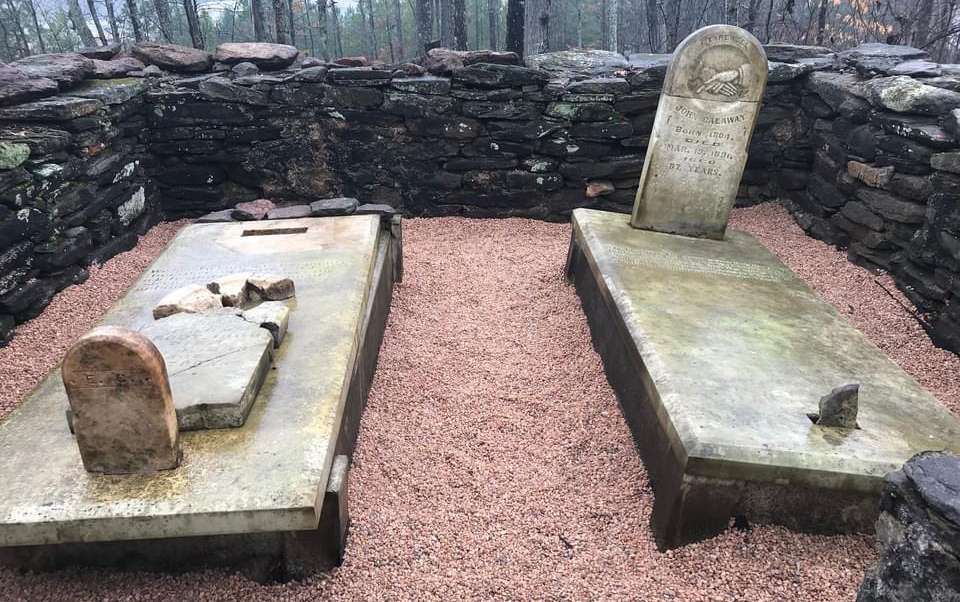On a wooded corner lot near White Oak Elementary School and Lanier Middle School is a small cemetery that belongs to some of the Sugar Hill area’s earliest settlers. The lot is protected by the Georgia Piedmont Land Trust.
This special site, the Calaway Family Cemetery, is just up a hill from the location of the original one-room Whiteoak School that operated in the early 1900s and about a mile from Island Ford Baptist Church and its cemetery. The Calaway Family Cemetery goes largely unnoticed, even though hundreds of vehicles pass it daily heading over Buford Dam to access Lake Sidney Lanier and Cumming in Forsyth County.
The cemetery, which contains only the graves of John and Elizabeth Calaway, is beautiful. The two graves are surrounded by a brick wall and the shade of trees provides dappled sunlight to visitors even during winter months. At one point in time before storm damage from fallen trees, an expensive wrought iron gate highlighted the entrance to the cemetery. There is still evidence of the heavy iron hinges — now rusted — that would have held up the gate. The site itself is historically significant, and John and Elizabeth contributed significantly to the history of this part of Gwinnett County, Sugar Hill, and Island Ford Baptist Church.
John was born in 1804 in Georgia, and Elizabeth was born in 1808 in North Carolina. Genealogical records indicate they were married about 1824. In the early 1830s, they would have been in their early 30s and late 20s — still in the early stages of their married life. It is hard to imagine what life would have been like on Georgia’s frontier, but it would have been important to put down roots by starting a family and by building bonds through church and other activities with others in the surrounding community that would become Sugar Hill. John and Elizabeth did both.
In our modern minds we often assume that individuals living in the past, like Elizabeth and John, had more time on their hands because they had less to do. In many ways, life was much more difficult. The area along the Chattahoochee River that is now Sugar Hill was once considered wilderness and the early settlers, without material wealth, would have worked hard to just survive. Church on Sunday would have been a welcome break and an opportunity to be with their community.
The earliest church established in the Sugar Hill Church was Island Ford Baptist Church. It was organized near the Chattahoochee River in 1833, near where early settlers forded the river at Bowman’s Island. The presbytery included Rev. Silas King, Rev. Richard Phillips and deacons Joseph Morgan, Sam Crowe and John Hammond. Charter members included John Calaway, as well as A. Humphries, N. Crossno, J. Pendley, W. Compton, J. Compton, M. Fields, T.M. Bagby, E. Bagby, S. Born, Jane Humphrey, Catherine Files, Susanna Phillips and Mary Bagby. The first church building was constructed out of rough-hewn logs — an inexpensive, but time-consuming endeavor.
John and Elizabeth’s faith and connection to their church is very clear in both their written words and deeds. John and Elizabeth spent considerable time and financial resources on their church and gravesites — no doubt because they cared about their community and legacy. The brick wall around their gravesites and their gravestones have outlasted the original building for Island Ford Baptist Church, their original home, the original Whiteoak School and so many other physical things that have been lost to time.
John’s epitaph reads:
“The last time He ever went to where he had selected to be buried, and wall built around the place; He laid His hands on the wall and said; Here is my sweet home till the day of Judgement; then went away.”




